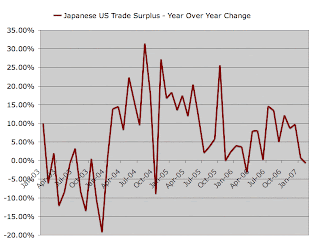Regional Factors in the Rebalancing Process
February's Trade Gap numbers showed a sixth straight year-over-year decline, strongly suggesting that the trade gap really has begun to rebalance. When you look at specific countries and regions, you can get a better idea of how and why it is happening:

While China continues its upward trend (ignore the seasonal fluctuations), Japan and Canada have been flat and Europe has shown a significant decline.
The biggest factors for the regional differences (in my mind) are related to individual currency strengths. The Euro has been on the rise since late 2005 and it eventually had the cummulative effect of narrowing the trade gap with the US. The Yen and Canadian dollar, meanwhile, have been volatile but essentially flat over the last year (Canada making up most of the North American trade gap). China has been slowly increasing the value of the RMB, but China's infrastructure and technical expertise are improving so fast that their competitive advantage is rising in spite of the currency shift.
Japan probably isn't happy about their stagnating exports to the US. They faced a similar problem in late 2003 and early 2004 with slowing export growth and a rising Yen. Back then they went balistic with currency interventions, selling Yen to buy US Dollars in order to surpress the value of the Yen. The strategy worked, and the trade surplus with the US began growing again:

That extreme intervention showed up as a big surge in Official Custodial Holdings at the Fed, but that is now being dwarfed by a new buying surge that has taken place in the first part of 2007:

Is Japanese intervention again behind the surge? I think in part it is. The other part is probably a result of the massive Yen carry trade in play. As Yen are borrowed into existence by hedge funds, and sold for dollars, these dollars find their way back to the Bank of Japan and then get spent on US debt securities. My casual observations of the US markets have had the appearance of a strong increase in carry trade activity, with the Yen weakening pretty much every time the US markets rally.
The carry trade has a huge positive long term impact for Japan. The Japanese banking system creates Yen out of thin air and loans them out at around 2% interest. If foreign investors are borrowing about $1 trillion per year, that's $20 Billion in profit for the Japanese economy, assuming that currency rates stay level. Of course the Bank of Japan will be in position to control the exchange rate as they have in the past. When it comes time to end the game, they can let the Yen rise in a controlled fashion to squeeze carry traders out of their positions for an additional 5, 10, 15% profit.
Defaults are a minor concern, so I expect the eventual rise of the Yen will be controlled. This would also protect Japanese manufacturers from a sharp, disruptive rise. Hedge fund managers will normally close down their funds and pay back their creditors before they go totally bust. This enables them to get back in the game because pleasing financiers is more important than pleasing investors. If played right, the Yen Carry Trade is free money for the Japanese economy at the expense of global hedge fund investors.
As for China, it is clear that the rate of change in the RMB simply hasn't been fast enough to reverse the growing trade gap with the US. However, the US consumer appears to be running out of fuel. With the mortgage equity engine stalled, and consumer debt burdens overextended, the US trade gap with China may soon contract under its own weight. China has already begun preparing for the day when most of their exports are to other regions and where domestic demand is increased with a rising standard of living.
Even with manipulation of the currency markets by Japan and China, global trade imbalances appear to be on an unavoidable path toward rebalancing.
Labels: trade gap

<< Home